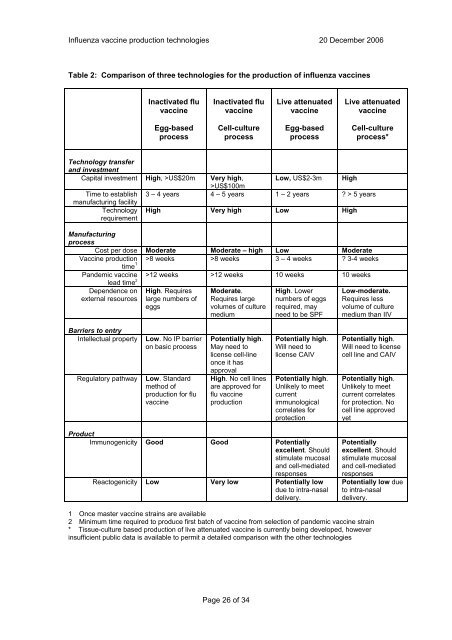A review of production technologies for ... - World Health Organization
A review of production technologies for ... - World Health Organization
A review of production technologies for ... - World Health Organization
You also want an ePaper? Increase the reach of your titles
YUMPU automatically turns print PDFs into web optimized ePapers that Google loves.
Influenza vaccine <strong>production</strong> <strong>technologies</strong> 20 December 2006<br />
Table 2: Comparison <strong>of</strong> three <strong>technologies</strong> <strong>for</strong> the <strong>production</strong> <strong>of</strong> influenza vaccines<br />
Inactivated flu<br />
vaccine<br />
Egg-based<br />
process<br />
Inactivated flu<br />
vaccine<br />
Cell-culture<br />
process<br />
Live attenuated<br />
vaccine<br />
Egg-based<br />
process<br />
Live attenuated<br />
vaccine<br />
Cell-culture<br />
process*<br />
Technology transfer<br />
and investment<br />
Capital investment High, >US$20m Very high,<br />
>US$100m<br />
Low, US$2-3m High<br />
Time to establish 3 – 4 years 4 – 5 years 1 – 2 years ? > 5 years<br />
manufacturing facility<br />
Technology<br />
requirement<br />
High Very high Low High<br />
Manufacturing<br />
process<br />
Cost per dose Moderate Moderate – high Low Moderate<br />
Vaccine <strong>production</strong> >8 weeks >8 weeks 3 – 4 weeks ? 3-4 weeks<br />
time 1<br />
Pandemic vaccine<br />
lead time 2<br />
Dependence on<br />
external resources<br />
>12 weeks >12 weeks 10 weeks 10 weeks<br />
High. Requires<br />
large numbers <strong>of</strong><br />
eggs<br />
Barriers to entry<br />
Intellectual property Low. No IP barrier<br />
on basic process<br />
Regulatory pathway Low. Standard<br />
method <strong>of</strong><br />
<strong>production</strong> <strong>for</strong> flu<br />
vaccine<br />
Moderate.<br />
Requires large<br />
volumes <strong>of</strong> culture<br />
medium<br />
Potentially high.<br />
May need to<br />
license cell-line<br />
once it has<br />
approval<br />
High. No cell lines<br />
are approved <strong>for</strong><br />
flu vaccine<br />
<strong>production</strong><br />
High. Lower<br />
numbers <strong>of</strong> eggs<br />
required, may<br />
need to be SPF<br />
Potentially high.<br />
Will need to<br />
license CAIV<br />
Potentially high.<br />
Unlikely to meet<br />
current<br />
immunological<br />
correlates <strong>for</strong><br />
protection<br />
Product<br />
Immunogenicity Good Good Potentially<br />
excellent. Should<br />
stimulate mucosal<br />
and cell-mediated<br />
responses<br />
Reactogenicity Low Very low Potentially low<br />
due to intra-nasal<br />
delivery.<br />
Low-moderate.<br />
Requires less<br />
volume <strong>of</strong> culture<br />
medium than IIV<br />
Potentially high.<br />
Will need to license<br />
cell line and CAIV<br />
Potentially high.<br />
Unlikely to meet<br />
current correlates<br />
<strong>for</strong> protection. No<br />
cell line approved<br />
yet<br />
Potentially<br />
excellent. Should<br />
stimulate mucosal<br />
and cell-mediated<br />
responses<br />
Potentially low due<br />
to intra-nasal<br />
delivery.<br />
1 Once master vaccine strains are available<br />
2 Minimum time required to produce first batch <strong>of</strong> vaccine from selection <strong>of</strong> pandemic vaccine strain<br />
* Tissue-culture based <strong>production</strong> <strong>of</strong> live attenuated vaccine is currently being developed, however<br />
insufficient public data is available to permit a detailed comparison with the other <strong>technologies</strong><br />
Page 26 <strong>of</strong> 34

















